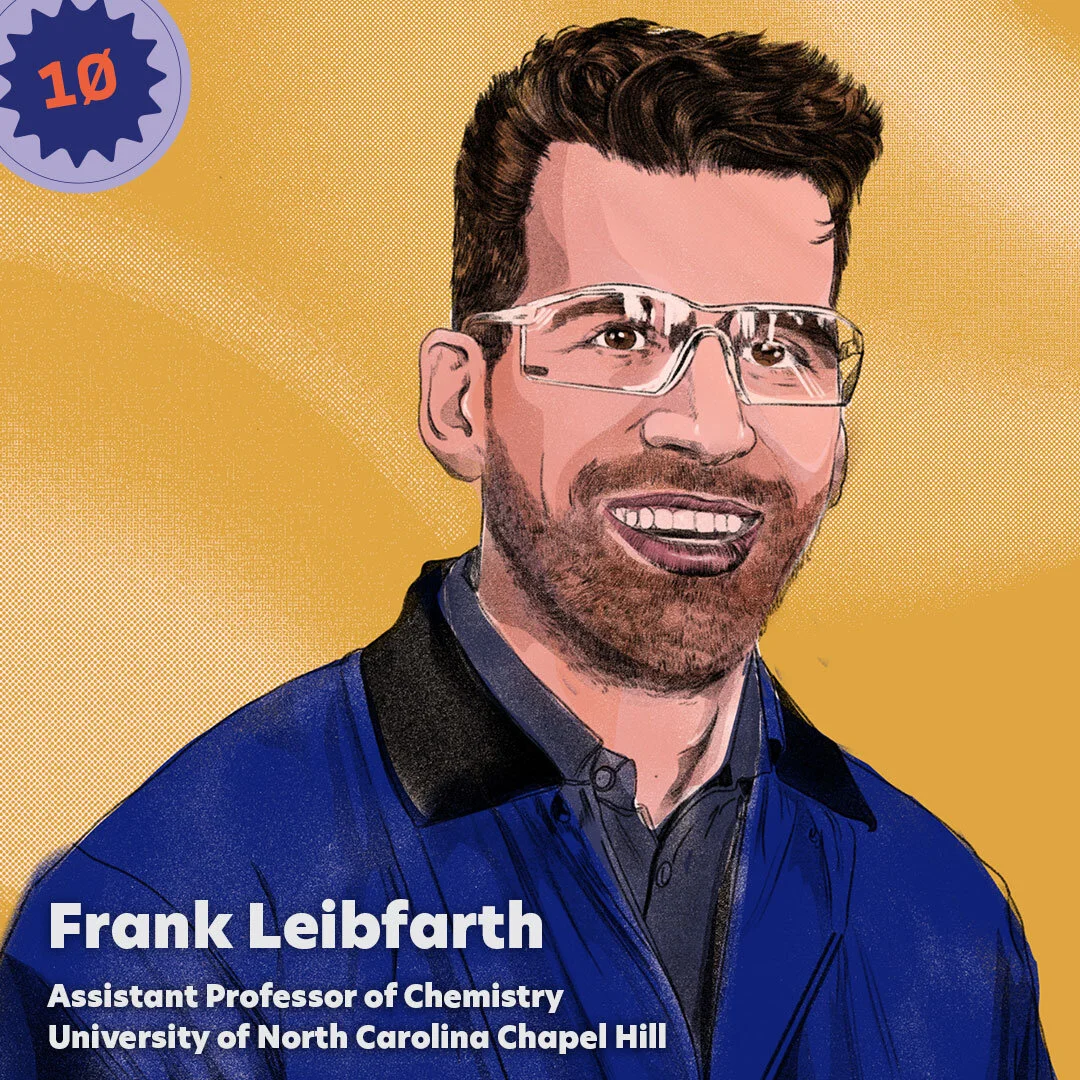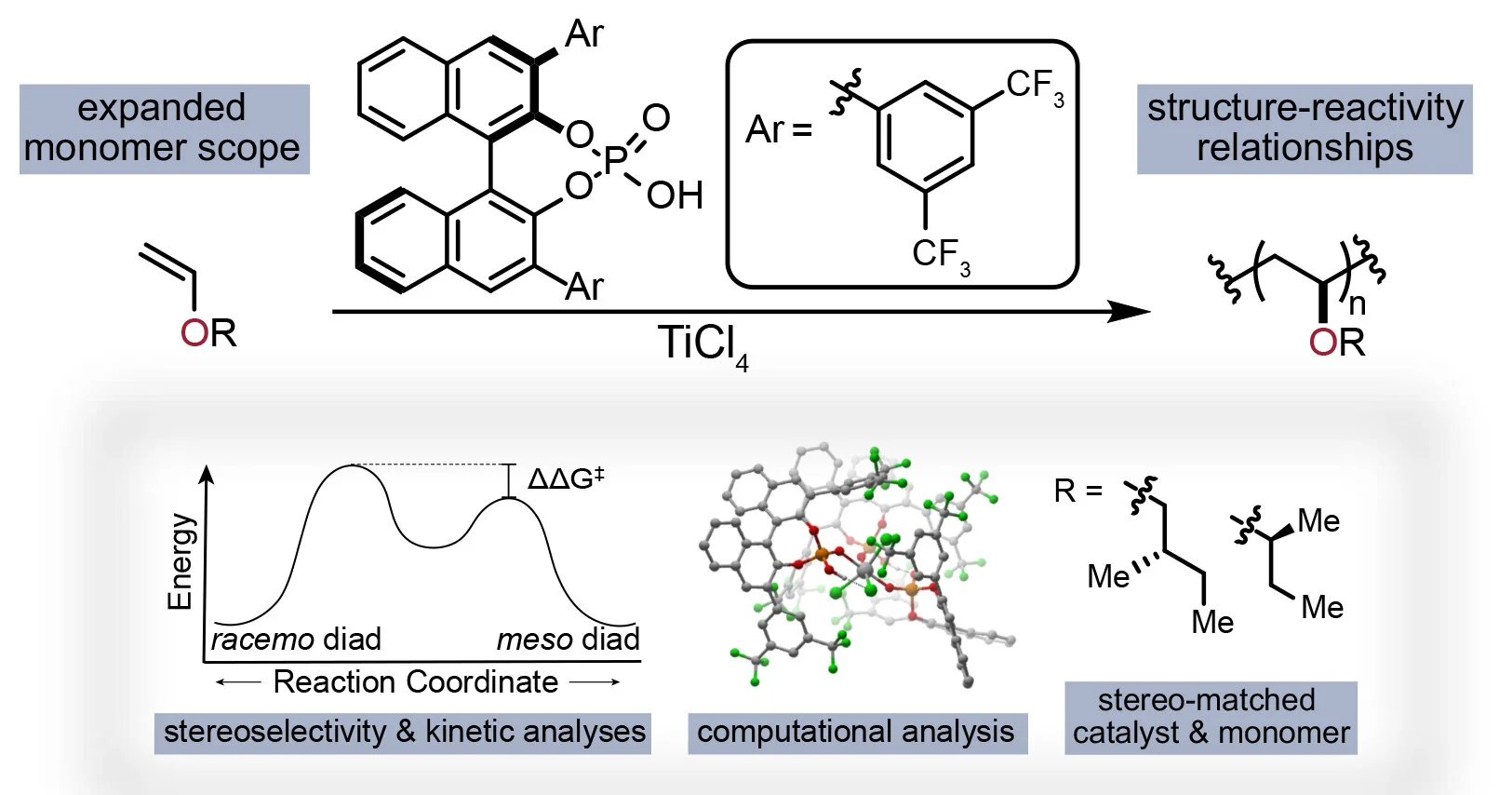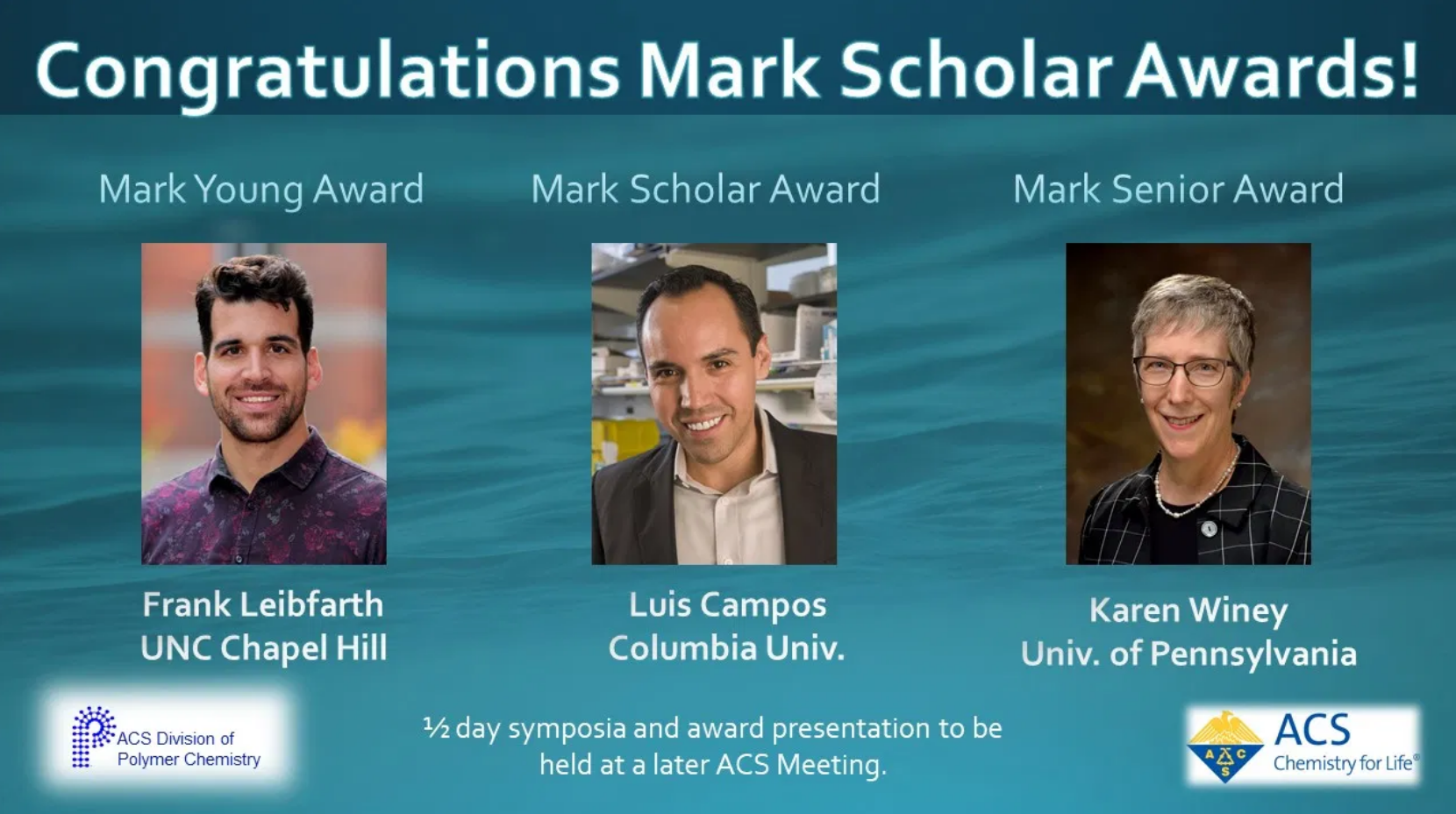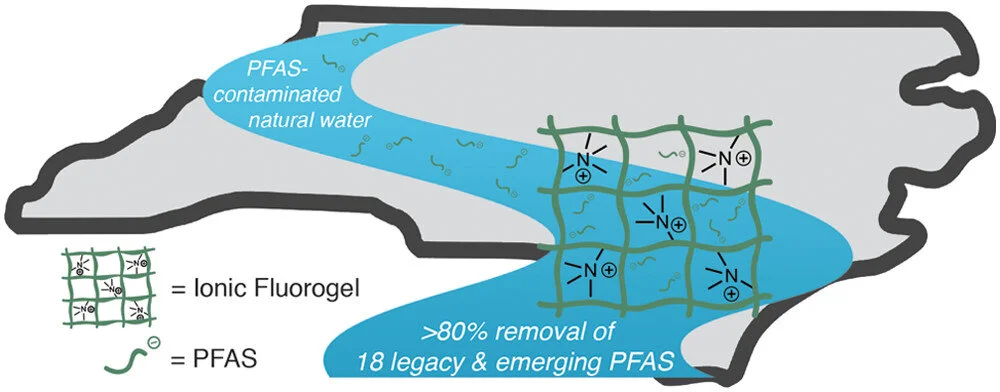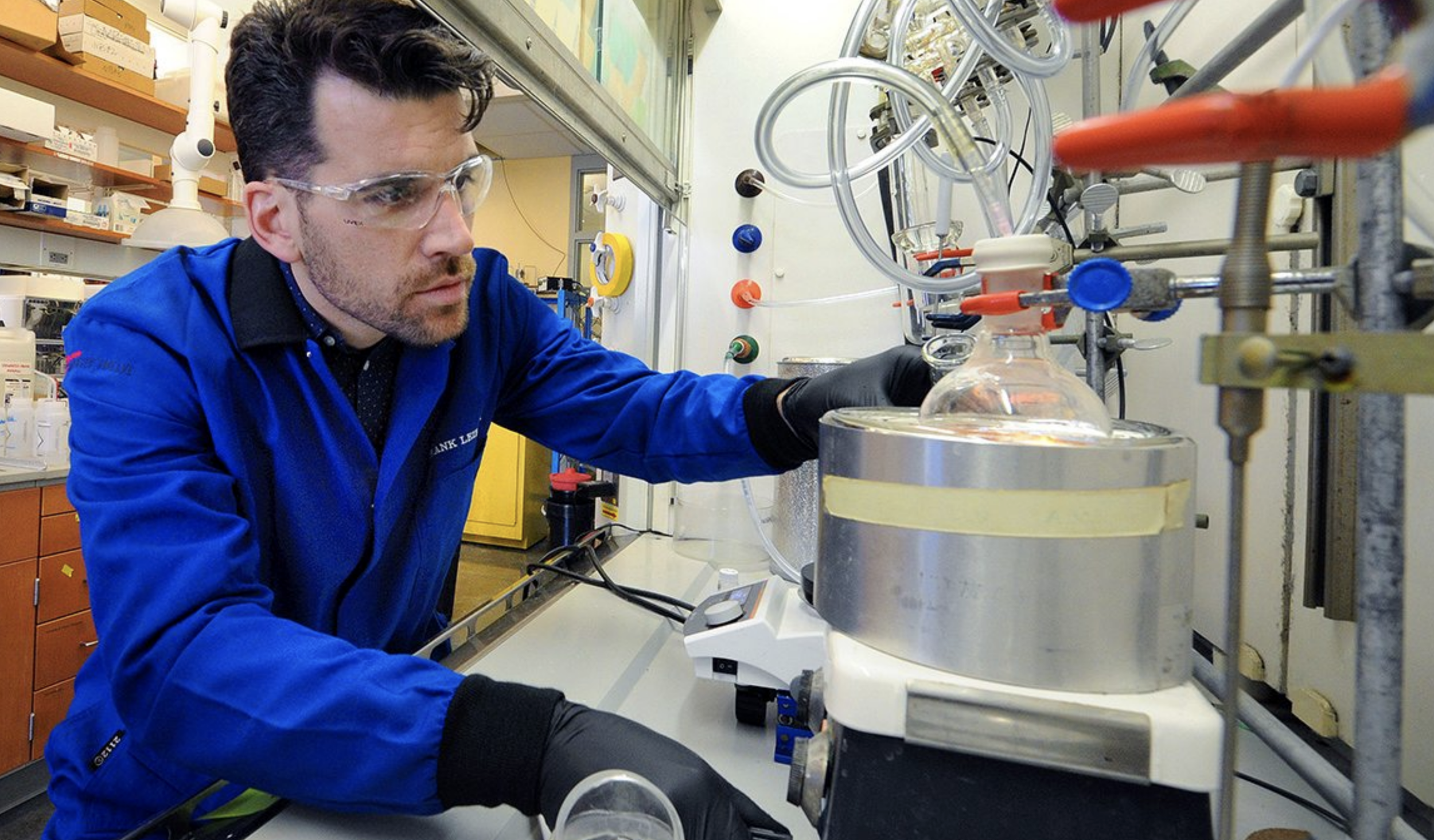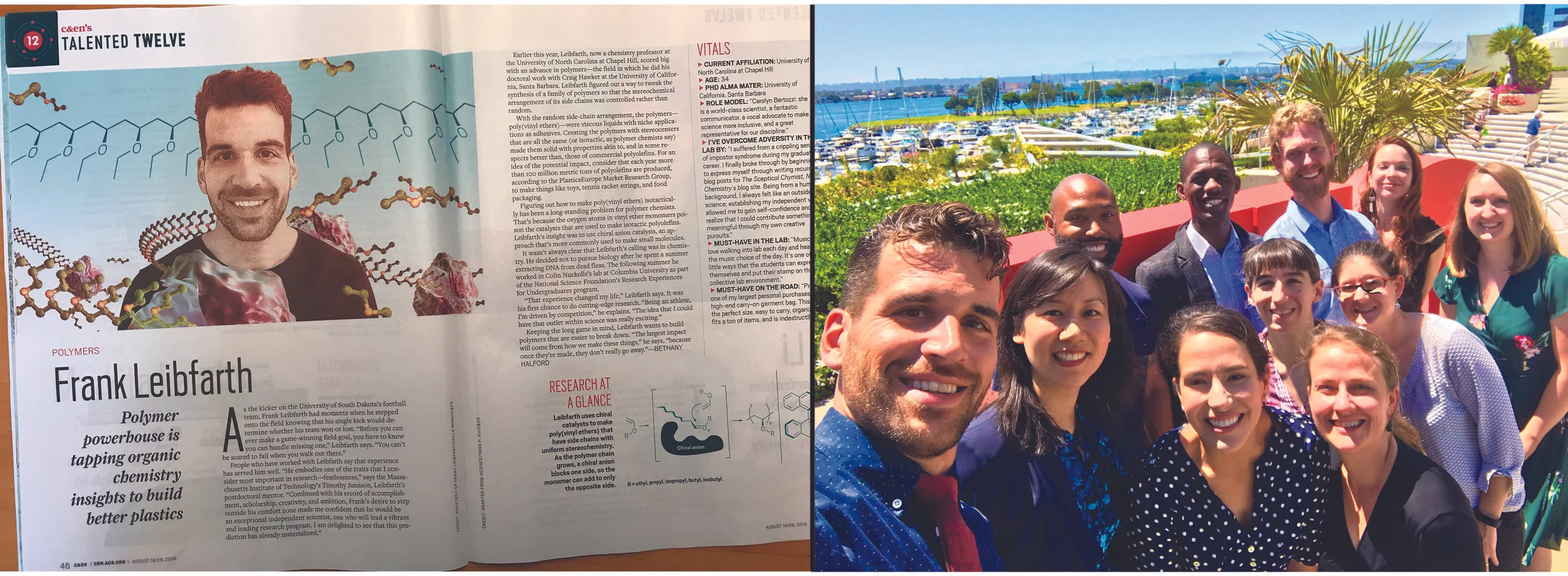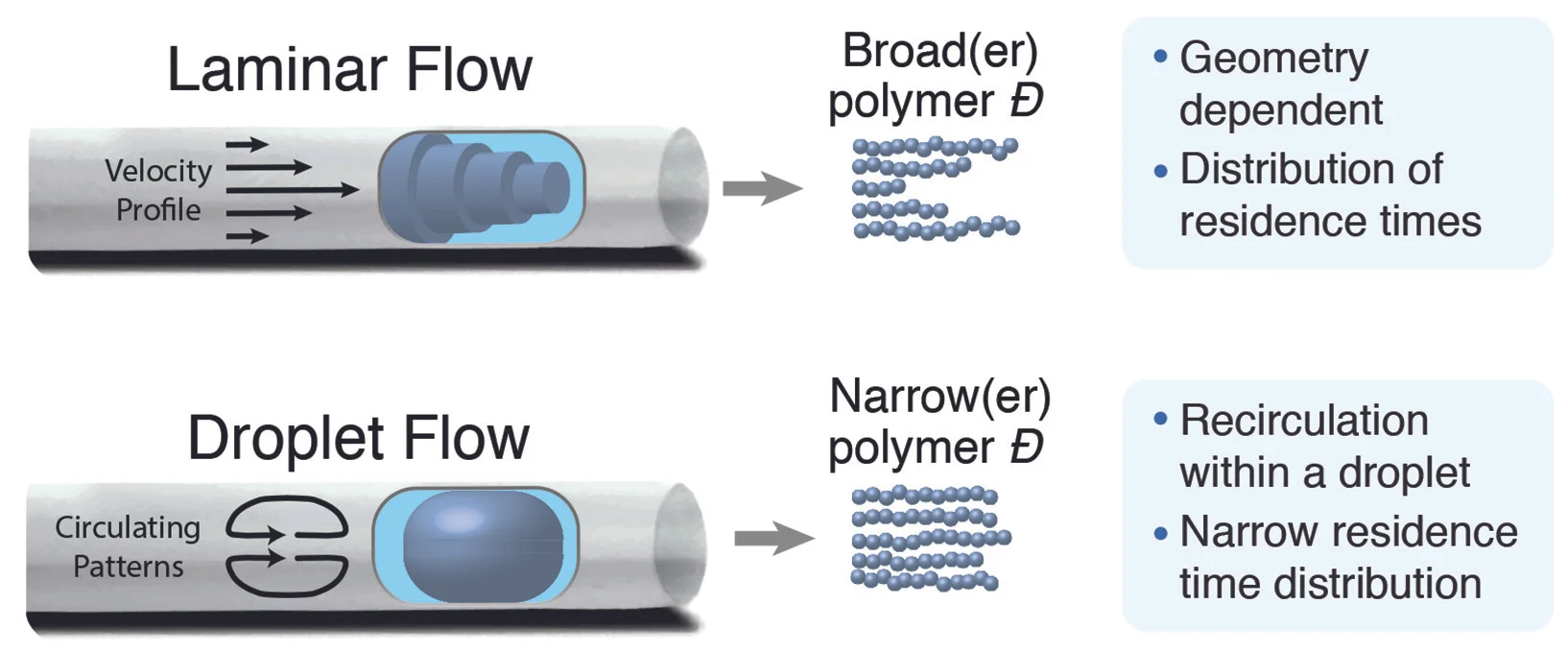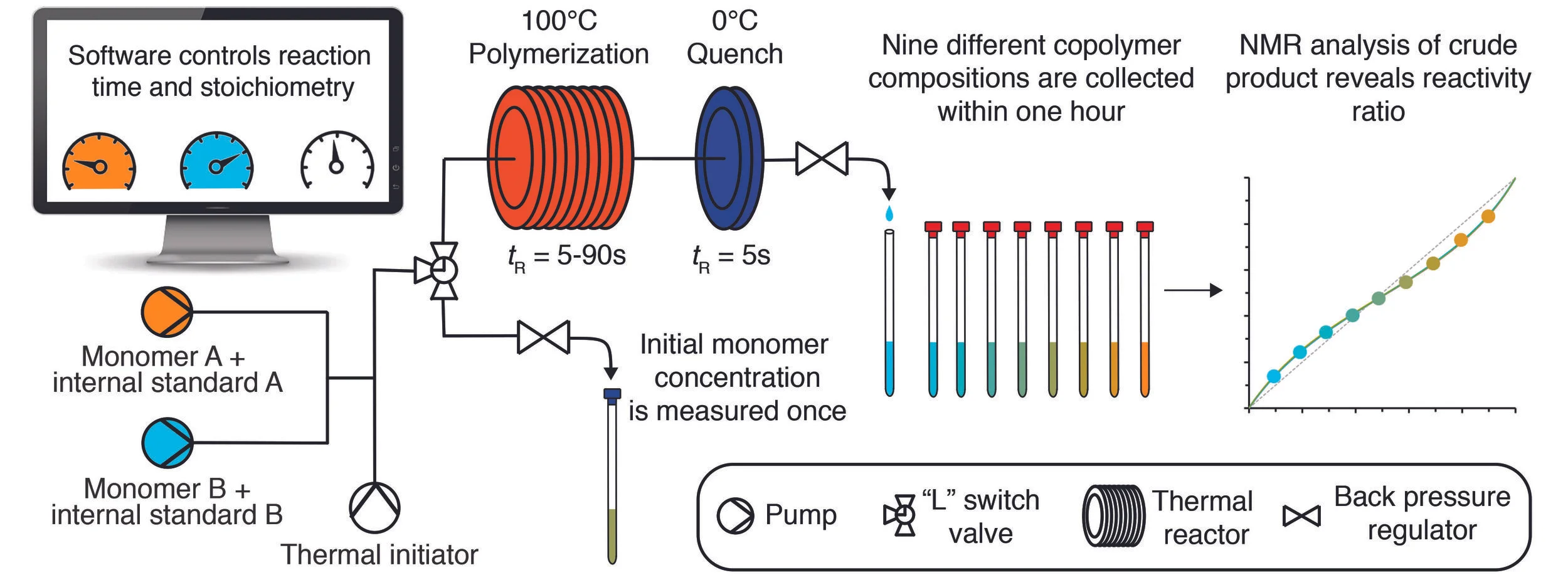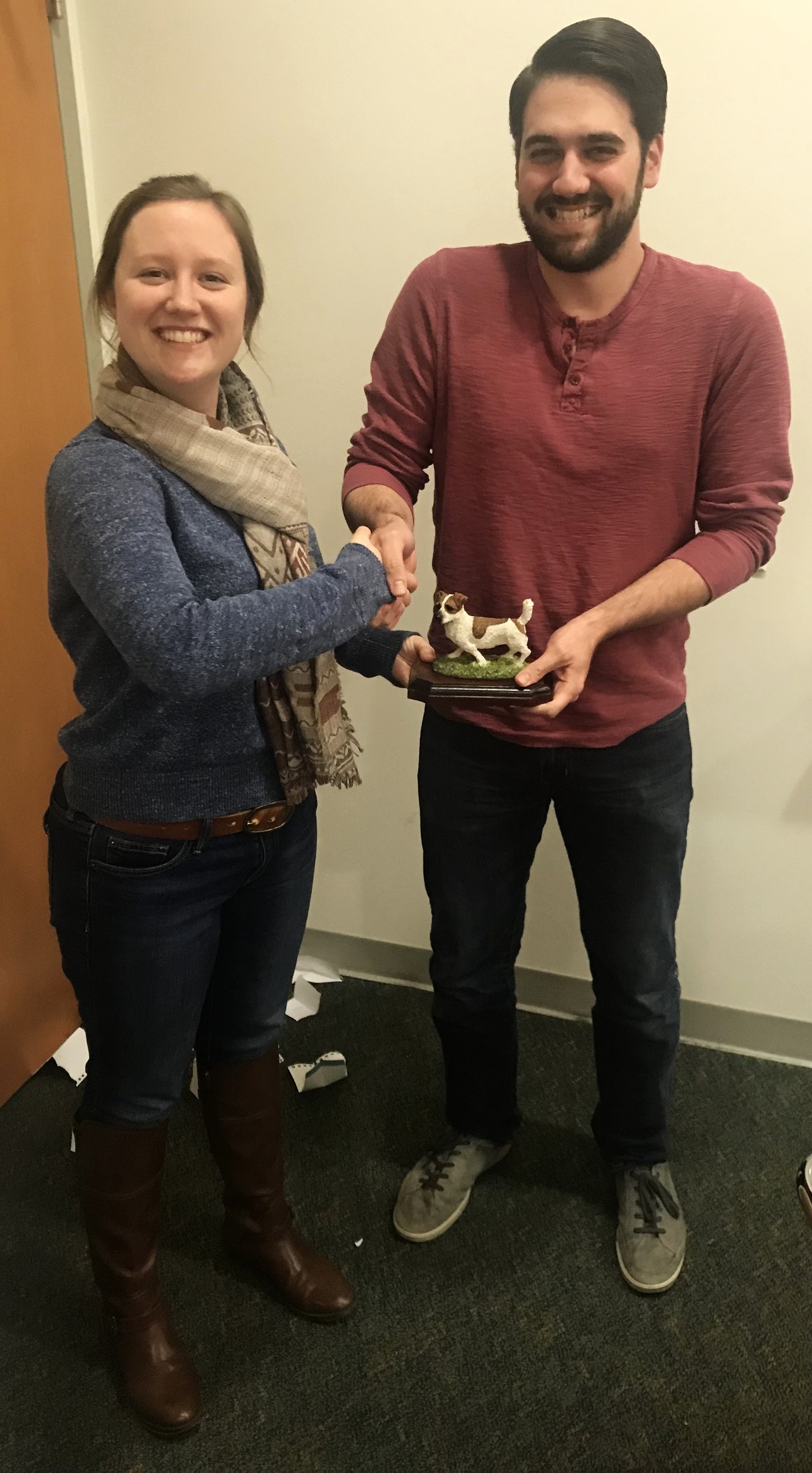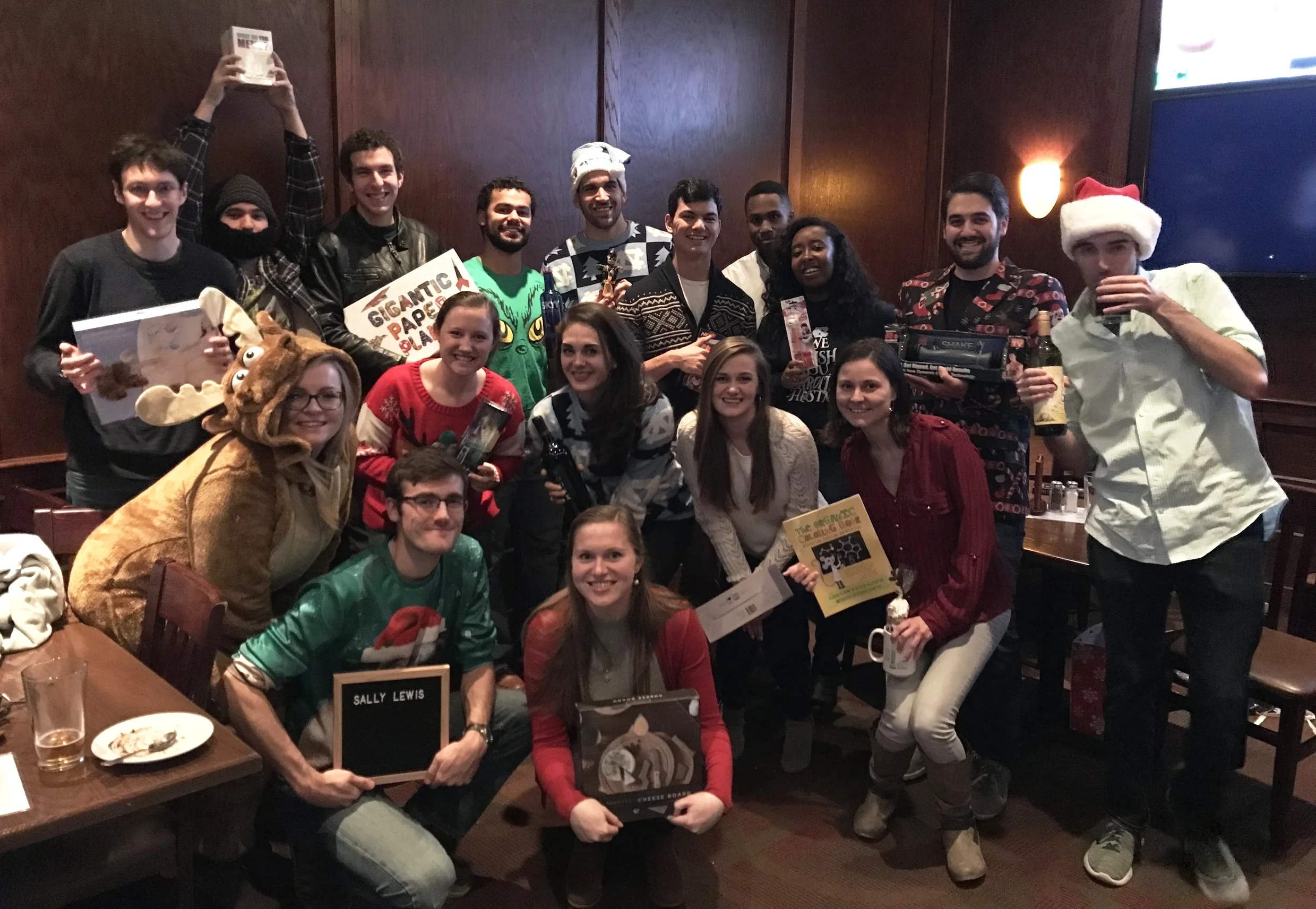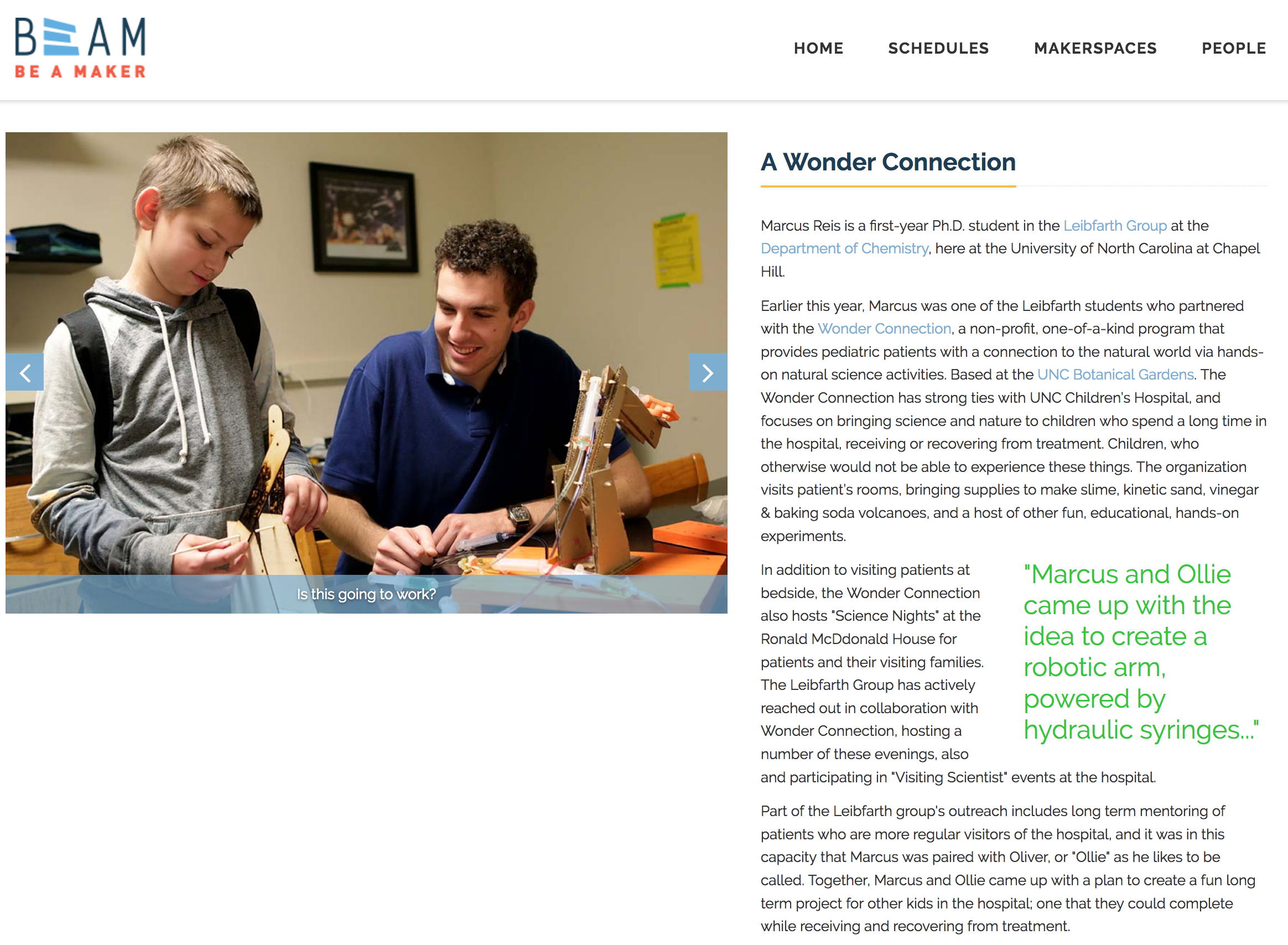Lab space + creativity:
The two requirements to cultivate great science and great scientists. Accompany us on a journey to uncover new chemical function and understand the complexities of biological interactions through polymer chemistry.
We welcome any and all individuals, regardless of identity, to join our group. We embrace each other’s identities as we celebrate our differences and our similarities. We vow to advocate for ourselves and our labmates in our science and beyond the bench as individuals. We pledge to continue to educate ourselves and colleagues in order to better cultivate a collaborative work experience for all.
Diversity Statement:
News:
Frank is named to Popular Science’s Brilliant 10
Frank was named to the 2021 “Brilliant 10” by Popular Science magazine. The Brilliant 10 is a list of early-career scientists and engineers solving challenging problems of societal need. The following introduction and outtake from the article about Frank by Bill Gourgey describes the list and work it supports:
“Fresh eyes can change the world, and a world stressed by a pandemic, climate change, and inequity is one more ripe for change than we have ever experienced before. That’s why, after a five-year break, Popular Science is bringing back the Brilliant 10: an annual roster of early-career scientists and engineers developing ingenious approaches to problems across a range of disciplines. To find those innovators, we embarked on a nationwide search, vetting hundreds of researchers from institutions of all stripes and sizes. These thinkers represent our best hopes for navigating the unprecedented challenges of tomorrow—and today.”
“Frank Leibfarth, a chemist at the University of North Carolina at Chapel Hill, has a filter that can remove these toxins—and he’s starting with the Tarheel State’s polluted waterways. Leibfarth specializes in fluorinated polymers like PFAS. Before the NC Policy Collaboratory funded him to help with the state’s water pollution problem in 2018, he was focused on finding cheap and sustainable alternatives to single-use plastics, whose exteriors are sometimes hardened with fluorine. Leibfarth’s solution took its cue from diapers: “They’re super-absorbent polymers that suck up lots of water,” he says. He developed a fluorine-based resin that’s similar enough in structure to PFAS to attract the compounds and hold on to them. The material filters nearly all of these substances from water, and 100 percent of PFOA and PFOS, according to results his team published in the journal American Chemical Society Central Science in April 2020. The material is cheap and scalable, so municipal water treatment plants can deploy the filters as an additional cost-effective filtration step.”
Our work on polyolefin functionalization is highlighted in C&E News
Recent work done by alumni Dr. Williamson-Alty, in collaboration with the Alexanian group at UNC, was presented by Frank at the ACS Spring 2021 meeting (Polymeric Materials: Science and Engineering Division) showing a powerful way to upcycle polyolefins through C-H functionalization. Previous work by our group showed the ability for amidyl radicals to functionalize polyolefins, however the radical-generating reagent and radical trap which functionalizes the polymer were coupled. In this work, new radical-generating reagents were designed by the Alexanian group which decoupled the radical-generating reagent and radical trap which functionalizes the polyolefin—allowing for a wide range of moieties to be installed.
Frank’s presentation was highlighted by C&EN, a weekly magazine published by the American Chemical Society, which delved into the work’s goal of transforming low-value polyolefins into more economically and sustainable materials. In the article, authored by Bethany Halford, a quote from Stuart Rowan, a faculty member at The University of Chicago and Editor-in-Chief of ACS Macro Letters, describes the research by saying, “The ability to functionalize commercial polyolefins in a facile manner and convert them into higher value products is the essence of polymer upcycling,” and calls the work, “an elegant method to functionalize polypropylene and convert it into ionomers. It will be interesting to see how far his team can push this technology and develop a new, valuable route to upcycling commodity plastics.”
Undergraduate Paige Jacky wins multiple awards!
Congratulations to undergraduate Paige Jacky for her multiple awards and recognitions this Spring. Paige has been part of the group for over two years and has been involved in multiple research publications. While the research group has known of her talents and abilities, she has recently received many high-profile recognitions. First, she received the prestigious 2020 National Science Foundation Graduate Research Fellowship Program (NSF GRFP) to fully fund her upcoming graduate career at Cornell University Chemistry Department. In addition, the University of North Carolina at Chapel Hill Chemistry Department announced she will received the 2021 Francis P. Venable metal, which is given to the two top graduating seniors for outstanding service and research. Most recently, Paige successfully defended her honors thesis on her work making and characterizing isotactic polyvinyl ethers from bio-sourced monomers!
Frank is named a 2021 POLY Fellow
Prof. Frank Leibfarth was recently named a 2021 POLY Fellow in recognition of research excellence in polymer science. The POLY Fellows Program was established by the POLY division of the ACS in 2009 to recognize members who have advanced the field of polymer science. Frank will formally receive this recognition in this upcoming Fall ACS meeting.
Prof. Frank Leibfarth has been awarded the 2021 Tanner Award for Excellence in Undergraduate Teaching from the University of North Carolina at Chapel Hill. The awards were created in 1952 to recognize excellence in inspirational teaching of undergraduate students, particularly first- and second-year students. The University Committee on Teaching Awards encouraged students to nominate deserving faculty with specific examples that display the nominees’ care for students, mentorship and effective use of classroom methods. Prof. Leibfarth received the award for his work teaching CHEM 102 (General Chemistry), CHEM 421 (Polymer Synthesis), and CHEM 520L (Polymer Lab) over his 4.5 years at UNC.
Since its inception, a central goal in our group has been to explore research areas at the interface of modern asymmetric catalysis and stereoselective polymerizations. When asked to write a Perspective article for ACS Macro Letters in commemoration of the 100th Anniversary of Macromolecular Science, we identified stereocontrolled vinyl polymerizations as the topic that we thought best defined the past century of polymer science while still holding tremendous potential for future innovations. While it is well-known that control over the tacticity of a polymer has a large influence on the material properties, method development of stereocontrolled polymerizations has remained underdeveloped. This is especially true for materials containing polar functionalities or are derived from renewable resources. In our Perspective “The Past, Present, and Future of Stereocontrolled Vinyl Polymerizations” we provide a summary of past advances, beginning with the discovery of isotactic polypropylene by Giulio Natta, and provide our prospective on the future of this burgeoning research area. Congrats to Aaron Teator, Travis Varner, Phil Knutson, and Cole Sorenson on putting this paper together!
Frank was recently interviewed as part of the “Bringing Chemistry to Life” podcast series sponsored by Thermo Fisher Scientific. In the episode, Frank talks about his early motivations for pursuing science, his career trajectory up to this point, and the exciting research his group is pursuing at UNC Chapel Hill. The podcast series interviews a collection of C&E News Talented 12 awardees, including Dr. Steven Townsend of Vanderbilt University and Dr. Cora Young of York University (as of 11/24/20). Check out all the excellent interviews and thank you to Thermo Fisher Scientific for highlighting these talented young scientists!
Our paper studying the mechanism of stereoselective cationic vinyl ether polymerization is published in Journal of the American Chemical Society
Congratulations to graduate student Travis Varner who, with the help of postdoc Aaron Teator and UNC undergraduate Paige Jacky, started a long journey three years ago to understand the mechanism of our previously published stereoselective polymerization of vinyl ethers. While our initial paper demonstrated an unprecedented method for the synthesis of highly isotactic poly(vinyl ether)s, it left many questions unanswered on the mechanism of the reaction: Why was so much ligand needed? Why was order of addition so important? How can we expand the scope to other substrates? The team performed a wide range of experimental stuides to try and answer these question, including lots of time measuring kinetics using in situ IR to understand the Arrhenius behavior of the system. An Eyring analysis of stereoselectivity provided quantitative values for the difference in transition state energies that lead to stereoselectivity. To understand the solution-state catalyst structure, the help of valuable collaborators Dr. Yernaidu Reddi and Prof. Chris Cramer from the University of Minnesota provided detailed computational information. As a fortuitous outcome of their fundamental work, the group discovered that using enantioenriched monomers led to a match-mismatch effect that resulted in the highest selectivity ever reported for a poly(vinyl ether) 95 % meso diads. To learn all the gory details, check the paper out here (link)!
Aaron Teator receives Cottrell Postdoctoral Fellowship
Aaron Teator was awarded a Cottrell Fellowship from the Research Corporation for Science Advancement (RCSA)! The prestigious fellowship includes $75,000 for a 12-month period salary, benefits, and research-related expenses for the 2020-2021 academic year and 2021 summer. As a Cottrell scholar, Aaron will continue his work on metal-free, controlled stereoselective polymerization of vinyl ethers. Beyond funding research, this fellowship also gives Aaron the opportunity to teach a course in the fall semester and refine his teaching philosophy and skillset. Read more about Aaron and the award in this highlight by the UNC Chemistry Department.
Two Leibfarth Group graduate students receive fellowships
Congratulations to Sally Lewis and Jill Williamson on being honored by the UNC Chemistry Departmental with prestigious fellowships this year. Sally was awarded the Eliel Fellowship; this fellowship is awarded to two outstanding graduate students in the department regardless of year and covers the stipend and fees of the fall 2020 semester. Jill was awarded the Venable Award, which covers one year of stipend and fees as well as a cash prize. This award is given to three outstanding fifth year graduate students in the department. Congrats to Sally, Jill, and all UNC graduate students honored with fellowships this year.
Frank receives the Herman Mark Young Scholar Award
Frank Leibfarth, Assistant Professor, is a recipient of the 2020 Herman F. Mark Young Scholar Award. The Mark Young Scholar Award is given to a polymer scientist age 35 or younger. The Mark Scholar Awards were established in 2006 to recognize excellence in basic or applied research and leadership in polymer science. The awards are administered by the POLY division of the ACS. The award was presented at the virtual 2020 Fall ACS National Meeting, held from August 17-20, 2020. Also a big congratulations to Prof. Luis Campos and Prof. Karen Winey, fellow recipients of Mark Scholar designations in 2020.
Congratulations to Nick Taylor and collaborators on our most recent publication in Chemistry – A European Journal titled “Partially fluorinated copolymers as oxygen sensitive 19F MRI agents”! For this study Nick joined forces with Dr. Yueh Lee of the UNC Department of Radiology to design and develop a library of water-soluble copolymers that serve as 19F MRI agents. In order to better understand their structure–property relationships, Prof. Yaroslava Yingling and her group at NC State University provided key computational analysis. Overall, these copolymers demonstrated higher 19F MRI sensitivity than state-of-the-art materials and demonstrated the first report of water soluble 19F MRI agents that can provide non-invasive quantification of oxygen concentration in solution. These materials show promise as modular alternatives to the perfluorinated small molecules that have previously helped clinicians identify low-oxygen, or hypoxic, regions in the body. Hypoxic regions have been shown to be linked to a variety of pathologies including cancer and peripheral artery disease. Good work Nick and the team!
Group members participate in Sci-athon
Congratulations to all participants in the second annual Sciathon event! Sciathon is a collaborative event for graduate students and post-docs in the triangle, where a multi-disciplinary global challenge is presented to students who are broken up into groups and charged with the task of finding a solution. This year’s Sciathon, co-organized by our own Irene Manning, was an 48-hour online event focused on proposing solutions to “Challenges in a Post-Industrial World”. From the Leibfarth Group, Phil Knutson led the first-place team and their presentation on ‘Phototherapy via Telehealth’, and Jill Williamson and Alexis Sarabia’s teams gave great presentations on ‘Soft Robotics as an Alternative for Pesticides’ and ‘Degradation of Polystyrene’ respectively. Good work everyone!
Frank receives the Camille Dreyfus Teacher–Scholar Award
Frank was recently named one of the 14 recipients of the 2020 Camille Dreyfus Teacher–Scholar Award given by the Camille & Henry Dreyfus Foundation. The award will provide $100,000 in unrestricted funds to pursue research and educational activities related to work in the Leibfarth research group on “Modern Approaches to Functional & Sustainable Thermoplastics.” The Camille Dreyfus Teacher–Scholar Award funds faculty in the first five years fo the academic careers that have created an outstanding independent body of scholarship and are deeply committed to education.
Graduate student Jill Williamson participates in the ACS Excellence in Graduate Polymer Research symposium
Each year at the Spring national meeting of the American Chemical Society, the ACS Division of Polymer Chemistry selects outstanding graduate students to present in special symposium to highlight their work. Our very own Jill Williamson was selected this year to receive the ACS Excellence in Graduate Polymer Research award in Philadelphia for her work using amidyl radicals to perform polyolefin C–H functionalization. Despite the meeting cancellation due to COVID-19 concerns, the organizers put together a platform to showcase the exciting research that the awardees have conducted to warrant their prize. Jill and 38 other oral presenters, as well as 15 poster presenters, can be found virtually presenting their research on https://www.polyacs.net/poly2020excellencesite. The oral presentations are roughly 10 minutes, so check out Jill’s during your next coffee break!
PFAS Work is Highlighted by Chemical & Engineering News and the Carolina College of Arts & Sciences Magazine
Our work recently published in ACS Central Science entitled “Ionic Fluorogels for Remediation of Per- and Polyfluorinated Alkyl Substances from Water” has captured the attention of multiple news organizations! Chemical & Engineering News, the weekly magazine published by the American Chemical Society, highlighted the work as part of their “Science Concentrates” section. Everyone in the group is avid readers of C&E News & we are honored by their recognition of this work and their continued support of innovative research in the chemical sciences.
Additionally, the Carolina College of Art’s & Science magazine highlighted the lab’s broader work with a specific focus on how our PFAS work is benefiting the state of North Carolina. The article does a great job weaving a story about how inspiration is sometimes sparked in science: an offhand comment by a colleague, many hours spent reading literature about diapers, and lots of help from friends and collaborators (in this case Orlando Coronell from the UNC Department of Environmental Science & Engineering).
Here is an excerpt from the article (written by Logan Ward) that does an outstanding job capturing the group’s approach to science: “Though well suited to the PFAS challenge, Leibfarth, who joined the Carolina faculty in 2016, had never worked on such a laser-focused, rapid-response project. The Leibfarth Group does basic scientific research to create sustainable plastics or develop ways to make existing plastics more sustainable.
“We are not so much problem-driven as we are method-driven,” Leibfarth said. “We’re interested in fundamental creativity.” Creativity is a big part of Leibfarth’s success. Raised in South Dakota, Leibfarth admits he wasn’t always into science. An athlete — he was a placekicker for the University of South Dakota football team — who learned carpentry skills from his father, Leibfarth fell in love with chemistry as an undergraduate on a summer National Science Foundation fellowship at Columbia University.
“Chemistry is quantitative. You have to have an analytical brain for it, but you also have to have this artistic way of thinking about molecules,” he said. “Chemists are makers. We make things with molecules.”
As a maker of molecules, Leibfarth strives for simplicity. “There’s a natural drive in science towards complexity,” he said. A polymer chemist might enhance a plastic by tacking on more and more functional groups, the way one creates a Lego structure, adding block after block. But that approach might weaken the structure or increase production costs or reduce sustainability. “We’re finding that we can get high-performing materials from simple building blocks if we focus on understanding how to control their structure and connectivity in previously unforeseen ways,” he said. “That’s the fun part of working at the interface of disciplines.”
One of his lab’s breakthroughs involves developing a sustainable plastic from a common substance by controlling the stereochemistry of polymers in a way that was previously undiscovered. Another involves creating catalysts that make throwaway thermoplastics more economical to upcycle. With the PFAS work, Leibfarth has entered a new realm — environmental engineering…”
Three Graduate Students join the Leibfarth Group!
Three first year graduate students have joined the Leibfarth group in 2020! From left to right, starting with Victoria Barber, is an Alabama native joining us from Spelman College in Georgia where she studied chemistry. She will use her skills to research polymer C–H functionalization. Following his B.S. in biochemistry from Santa Clara University, California native Alexis Sarabia obtained his M.S. in chemistry from San Jose State University. His unique skills will be applied to the area of flow chemistry. Cole Sorensen, another California native, obtained his degree in nanoscience from Virginia Tech. Cole will be joining our ongoing research efforts in stereoselective polymerization. Look out for these three talented scientists in the coming years!
Congratulations to Dr. Elango Kumarasamy (postdoc alumni) and Irene Manning (graduate student) for their publication in ACS Central Science entitled “Ionic Fluorogels for Remediation of Per- and Polyfluorinated Alkyl Substances from Water.” In collaboration with the Coronell Research Lab in the Gillings School of Global Public Health here at UNC, Elango and Irene synthesized and analyzed a systematic library of Ionic Fluorogels, which leverage both fluorophilic and electrostatic interactions to remove PFAS from water. The materials demonstrate efficient, selective PFAS removal in a variety of water matrices, including PFAS-spiked settled water from the Cape Fear River in NC. In addition to elucidating design principles for new PFAS sorbents, this work represents a collaborative, interdisciplinary pursuit of fundamental chemistry research with direct ties to the state of North Carolina.
Additionally, a “First Reactions” piece entitled Fighting PFAS with PFAS was published by Prof. Rafael Verduzco and Prof. Michael Wong about our work in ACS Central Science
Frank receives two prestigious awards for young scientists: The Alfred P. Sloan Research Fellowship and the Cottrell Scholar Award
The following story was published by the UNC College of Arts & Sciences & is reproduced here:
Frank Leibfarth, assistant professor of chemistry in UNC’s College of Arts & Sciences, has won two prestigious awards for early-career scientists. In only one week, he has been awarded an Alfred P. Sloan Research Fellowship and a Cottrell Scholar Award for 2020.
Sloan Fellowships, given by the Alfred P. Sloan Foundation, are presented to early-career scientists and scholars whose achievement and potential identify them as “rising stars” — the next generation of scientific leaders. Awarded yearly to 126 of the brightest young scientists across the U.S. and Canada, the Sloan Fellowships are one of the most competitive and prestigious awards available to early-career researchers.
Cottrell Scholar Awards, presented by the Research Corporation for Scientific Advancement, are given to early-career scholars who are identified as leaders in integrating scientific teaching and research. Leibfarth was among 25 winners of this award.
“To receive a Sloan Research Fellowship is to be told by your fellow scientists that you stand out among your peers,” said Adam F. Falk, president of the Alfred P. Sloan Foundation. “A Sloan Research Fellow is someone whose drive, creativity and insight makes them a researcher to watch.”
Leibfarth’s research focuses on synthetic polymers, commonly known as plastics, which protect us from extreme weather, improve the fuel efficiency of cars, enable prolonged food storage and help cure diseases. Polymers are substances made from strings of single molecules bonded together. While these versatile materials have made modern population expansion and globalization possible, innovations in polymeric materials are needed to address next-generation scientific and technological challenges in sustainability, water security, renewable energy and healthcare.
Leibfarth also netted a number of prestigious honors last year, including a Beckman Young Investigator Award, an NSF CAREER Award and an Army Research Office Young Investigator Award.
“Frank is one of the most creative and fearless scientists of his generation, strongly evidenced by his successful prosecution of problems that have vexed polymer scientists for decades,” said Jeffrey Johnson, chair of the department of chemistry.
Leibfarth received a Ph.D. in chemistry and biochemistry from the University of California, Santa Barbara, and a bachelor’s in chemistry and physics from the University of South Dakota. He arrived at Carolina in 2016.
Congratulations to Sally Lewis (graduate student) and Bradley Wilhelmy (undergraduate) for their publication in Polymer Chemistry entitled “Organocatalytic C–H Fluoroalkylation of Commodity Polymers”. This work was spearheaded by UNC undergraduate Bradley Wilhelmy, who began synthesizing a large variety of organic photoredox catalysts in his junior year. We quickly discovered that these catalysts demonstrated considerably different reactivity that didn’t scale cleanly with the reported reduction potentials. Specifically, many of the catalysts caused unwanted side reactions that broadened the molecular weight distributions of polystyrene upon functionalization. Subsequent work by the Jui Group out of Emory University highlighted a selection of these catalysts for direct C–F functionalization of electron deficient and unactivated aryl trifluromethyl groups, which we hypothesize is the cause of the deleterious reactivity that we observed. Bradley’s search eventually found an organic catalyst that provided metal-free polymer C–H fluoroalkylation, was also amenable to a range of perfluoroalkyl groups and polymer substrates, including post-consumer and post-industrial plastic waste. The methods developed and structure–reactivity relationships identified in this study will prove valuable for the continued adoption of C–H functionalization methodologies that enhance the properties of commercially available polymers.
Chemical & Engineering News released their annual “Year in Chemistry” edition showcasing the year’s hottest trends in chemistry research, coolest-looking molecules, and more! Therein, one of the three papers highlighted as “Sensational Syntheses of 2019” was the Leibfarth group’s report on the stereoselective polymerization of vinyl ethers using a chiral anion! Recognition like these makes us reflect on the winding road that this work required, the time in November 2017 when we almost abandoned the project all together, and the excitement we felt as the pieces of this fun puzzle started coming together.
We also are grateful to Chemical & Engineering News for their continued reporting on PFAS as a persistent pollutant, a subject that our group is also intently studying.
Congratulations to Aaron Teator (postdoc), Travis Varner (graduate student), Paige Jacky (UNC undergraduate), & Karolina Sheyko (high school intern) on their recent publication in ACS Macro Letters entitled "Polar Thermoplastics with Tunable Physical Properties Enabled by the Stereoselective Copolymerization of Vinyl Ethers". This followup from our previous publication explores how polymer tacticity, composition, and thermal properties are impacted when copolymerizing different alkyl vinyl ether monomers. The key finding herein is that our catalyst, which is composed of a chiral phosphoric acid in combination with TiCl4(THF)2, enables the stereoselective copolymerization of vinyl ether monomers with diverse chemical structure. Since this is the first catalyst with such a broad substrate scope, these highly isotactic poly(vinyl ether)s represent a new class of semicrystalline thermoplastics. We demonstrated that copolymerization led to statistical copolymers whose thermal properties could be systematically tuned by variations in chemical composition. Furthermore, kinetic studies revealed that alkyl vinyl ethers with linear side chains undergo copolymerization more quickly than those with branched side chains, which is different from from more traditional Lewis acid-catalyzed cationic polymerizations of vinyl ethers. Lastly, we demonstrate that a vinyl ether with an protected alcohol undergoes stereoselective copolymerization and can be revealed for subsequent post-polymerization modification. Overall, this study provides deeper insights into stereoselective cationic polymerization and further demonstrates the exciting potential of isotactic poly(vinyl ether)s as a new class of semicrystalline thermoplastics.
Undergraduate Student Paige Jacky Wins Departmental Award
Congratulations to Paige Jacky for winning the Jason Altom Memorial Award for Undergraduate Research! This award is for undergraduate students majoring in Chemistry at UNC who have demonstrated excellence in research and scholarship. Paige has only been working in the Leibfarth group for one year but has already contributed to one manuscript as a coauthor. She has now begun to work on an independent project under the auspice of stereoselective vinyl ether polymerization. We anticipate that this is the first award of many for Paige!
Frank’s Talented Twelve Lecture is on YouTube!
The lecture Frank gave in the C&E News Talented Twelve Symposium at the ACS National Meeting in San Diego, CA, is now on YouTube. Take a listen if you want to hear about Frank’s journey in life and what led him to science (including embarrassing high school photos!). The second half of the lecture focuses on work the Leibfarth Group is pursuing to enhance the properties of plastics, including those derives from renewable resources, using stereoselective synthesis.
The Leibfarth Group took over the Chemical & Engineering News Instagram feed!
On September 12th, the editors at Chemical & Engineering News magazine trusted members of the Leibfarth group to takeover their Instagram story. What ensued is a mix of coffee(!), lab tours, a hotdog costume, a lecture by Craig Hawker, soxhlet extractions, 3D printing, & happy hour in Chapel Hill. If you want to know what a day-in-the-life of the Leibfarth Group is like and learn a little more about our research, check it out! While we don’t know if anyone will ever trust us again to takeover their social media platform…but we had a lot of fun! Check it out on C$E New’s Instagram feed here: LINK
Frank is selected as one of the Talented 12 by Chemical & Engineering News magazine
Chemical & Engineering News, the weekly magazine of the American Chemical Society, included Frank as one of the Talented 12 early career chemists for 2019. The Talented 12 “Highlights path-paving young scientists tackling the world’s toughest problems with clever chemistry”. The award was presented at the ACS National Meeting in San Diego, where each of the recipients gave a “TED-style” lecture to an audience of >300 scientists. During his lecture, Frank was able to thank the numerous mentors that have contributed to his chemical education, including Ranjit Koodali (USD), Colin Nuckolls (Columbia), Jim Hedrick (IBM), Craig Hawker (UCSB), Bongjin Moon (Sogang), Tim Jamison (MIT), & Jeremiah Johnson (MIT). The entire Leibfarth group is thrilled with this recognition of their creativity & dedication to polymer science.
Graduate student Marcus Reis receives the UNC Hiskey Graduate Research Fellowship
A big congratulations to Marcus Reis for receiving the UNC Hiskey Graduate Research Fellowship! The Hiskey Fellowship will cover Marcus’s tuition, fees, and stipend for the Fall 2019 semester. Over the last three years Marcus has dedicated his time to uncovering fundamentals of polymerization in continuous flow, diving into programing to make automated systems utilizing flow chemistry, and innovating experiential programs for undergraduate students at UNC and patients at the UNC Children’s hospital (check out our outreach page!). This past year he developed a course for undergraduate students at UNC to build a “recyclebot” from the bottom up that extrudes excess 3D printer scraps back into filament for reuse. His passion for research and outreach earned him this fellowship, and the group is looking forward to more big things from Marcus!
Congratulations to Jill Williamson (Leibfarth lab), Christina Na (Alexanian lab), Rob Johnson (Leibfarth lab), and Will Daniel (Dingemans lab) for their recent publication in JACS on thermally induced xanthylation of polyolefins! The latest publication of the Leibfarth–Alexanian collaboration further expands photo-initiated polymer C–H xanthylation to include thermally initiated polymer C–H xanthylation, trithiocarbonylation, and dithiocarbamylation. Thermal initiation was transformational to this project as this new series of studies elucidated key steps in the reaction mechanism as well as made reactive extrusion possible, a technique often seen in industrial practices. This paper includes the first report of metal-free chemo- and regio-selective functionalization of isotactic polypropylene, the world’s second largest volume commodity plastic. Upon reactive extrusion, functionalized isotactic polypropylene proved to adhere to glass surfaces twice as strongly as the virgin polymer, indicating the translational potential of this method for plastic upcycling.
Jill has been traveling around the world over the last few months presenting this work at a number of presigious conferences. Jill began the summer presenting “Amidyl Radical-Mediated Polyolefin C–H Functionalization” at the Polymers Gordon Research Seminar (GRS) to fellow graduate students and post-docs in South Hadley, MA. Impressed by her work, GRS attendees voted for her to speak at the corresponding Polymers Gordon Research Conference (GRC) as well. More recently, she presented this work at the Ewha-Luce International Seminar (ELIS) at the Ewha Woman’s University in Seoul, South Korea. Jill participated in the 18-day leadership seminar in Korea, designed to support and encourage female graduate students in science, technology, engineering, and mathematics in the US and Asia. At ELIS, Jill presented her work in a TED-style talk called “Nature & Science” on “Upcycling Plastic Waste”. She also enjoyed learning about Korean culture, eating new food, visiting Jeju, and came back with lots of candy and gifts for the lab!
Sally Lewis (with help from UNC undergraduate Bradley Wilhelmy) has spent the last few years chemically decorating Styrofoam waste. The project began with a simple photoredox mediated trifluoromethylation of polystyrene, which was inspired by the creative work of the Stephenson group at the University of Michigan. To our surprise, this method was incredibly chemoselective, providing fluorinated products that were easy to purify and quantify with no observable polymer degradation. We attribute this high selectivity to the unique reactivity of electrophilic radicals, which would much rather react with aromatic rings than pluck off hydrogen atoms from the polymer backbone. As we began to increase the amount of fluorine incorporated, the polymer became soluble in a range of organic solvents and static water contact angles just kept increasing. This approach also worked on other high volume aromatic polymers, including polycarbonate and polyethylene terephthalate. To further demonstrate the utility of this method, Sally also found that functional units could be attached to the polymers, which enabled the graft-co-polymerization of other materials from the backbone of a commodity polymer. Diversifying the properties of commodity plastics earned this paper the title of Paper of the Week in Chemical Science and was highlighted in Chemistry World (C–H Fluoroalkylation Tackles Plastic Waste).
Frank is one of 10 scholars to be named a 2019 Beckman Young Investigator by the Arnold and Mabel Beckman Foundation. The award, which comes with $600,000 in funding over four years, supports the nation’s most promising young faculty members in the early stages of their academic careers in the chemical and life sciences, particularly to encourage work that opens up new avenues of research.
The Beckman Young Investigator Award will fund work in the group focused on developing the next-generation of sustainable plastics. The majority of current plastics are derived from petrochemical resources and persist in the environment long after their useful lifetime. While these materials would ideally be replaced by plastics that are both derived from renewable resources and degrade into environmentally benign byproducts, the majority of current sustainable alternatives do not have the properties to compete with petroleum-derived materials.
The group will use the Beckman Young Investigator funding to develop a new approach toward the production of sustainable plastics with the potential to dramatically enhance their mechanical properties. Dr. Aaron Teator in the group has recently discovered a new concept to control polymer stereochemistry using asymettric ion-pairing catalysis. Translating this concept to building blocks that are derived from biorenewable substrates such as corn, mint and trees will yield next-generation plastics with a significantly smaller environmental footprint. Additionally, the production of these high-value materials from renewable building blocks will result in plastics that are considerably easier to degrade either chemically or in the environment.
The Arnold and Mabel Beckman Foundation supports researchers and nonprofit research institutions in making the next generation of breakthroughs in chemistry and the life sciences. The list of current and past awardees of the Beckman Young Investigator comprise some of the most creative scientists conducting interdisciplinary research int he U.S.
Aaron Teator took a chance to begin his postdoc in our newly formed lab. He began working on an ambitious project to harness chiral anions to control the stereoselectivity of cationic polymerizations. The challenges were many, but Aaron overcame each of them to discover a method for the polymerization of a class of isotactic poly(vinyl ether)s. These materials have similar mechanical properties to commercial polyolefins but adhere to class 14 times stronger than low-density polyethylene.
We took inspiration from previous work in the field of asymmetric catalysis to design catalysts that control the facial addition of each monomer unit to the reactive polymer chain end. This enabled the realization of a general method for the synthesis of isotactic poly(vinyl ether)s. After the synthesis of these materials, we quickly noticed their impressive material properties. They felt exactly like a sheet of polyethylene, yet they stuck strongly to the vials in which we isolated them. After quantitative tensile testing, we determined that they had almost identical mechanical properties to commercially available samples of low density polyethylene but adhered to glass 14 times stronger than commodity polyolefins. We hope both the concept of chiral counterion catalysis for stereoselective polymerization and the utility of isotactic poly(vinyl ether)s will benefit the scientific community.
Marcus and Travis collaborated to determine how fluid dynamic phenomenon inherent to tubular microreactors affect polymer composition and structure in continuous flow polymerizations.
Summary: Continuous-flow chemistry is emerging as an enabling technology for the synthesis of precise polymers. Despite recent advances in this rapidly growing field, there remains a need for a fundamental understanding of how fluid dynamics in tubular reactors influence polymerizations. Herein, we report a comprehensive study of how laminar flow influences polymer structure and composition. We found that the breadth of the RTD has strong, statistical correlations with reaction conversion, polymer molar mass, and dispersity for polymerizations conducted in continuous flow. These correlations were demonstrated to be general to a variety of different reaction conditions, monomers, and polymerization mechanisms. Additionally, these findings inspired the design of a droplet flow reactor that minimizes the RTD in continuous-flow polymerizations and enables the continuous production of well-defined polymer at a rate of 1.4 kg/day.
Frank has recently been selected to receive the Young Investigator Prize (YIP) from the Army Research Office. YIP awards are one of the most prestigious honors bestowed by the Army on outstanding scientists beginning their independent careers. The objective of the YIP is to attract outstanding young university faculty members to pursue fundamental research in areas relevant to the Army, to support their research in these areas, and to encourage their teaching and research careers.
The Army Research Office bestowed Professor Leibfarth this award for his work making plastics with emergent properties from readily available building blocks. To accomplish this task, the Leibfarth group is seeking to use concepts derived from the stereoselective synthesis of small-molecule pharmaceuticals and apply them to the production of next-generation plastics. The three-year award will provide $360,000 to fund research on developing new synthetic methods toward these materials and testing their properties for applications in high-value composites, blends, adhesives, and more.
Our group is working hard to understand where and why methods for the C–H Functionalization of Commodity Polymers will be important. We have some ideas…and we also recognize the significant contributions made in the field by many scientists. To share our thoughts with the rest of the community and demonstrate the breadth of this field, Jill, Sally, Rob, and Irene compiled a Minireview on the subject. We hope you enjoy reading about a field that will think will make significant contributions to polymer science in the coming future.
Short Summary: Synthetic manipulation of polymer substrates is one of the oldest and most reliable methods to increase the functional diversity of soft materials. Modifying the chemical structure of polymers that are already produced on a commodity scale leverages the current high-volume and low-cost production of commodity plastics for the discovery of modern materials. This Review discusses the historical significance of and contemporary advances in the C–H functionalization of commodity polymers. The conceptual approach outlined herein presents exciting new directions for the field, including increasing the value of otherwise pervasive materials, uncovering entirely new material properties, and a viable path to upcycle post-consumer plastic waste.
Jill Williamson, a third year in the Leibfarth Group, was one of four UNC Graduate Students to receive the Clare Boothe Luce Fellowship! The $300,000 grant for which Jillian Dempsey is the principal investigator and director, supports three new graduate fellowships for women in chemistry at UNC-Chapel Hill. The fourth fellowship is provided by UNC. The fellowships will be used to support and nurture women graduate students who are aspiring to tenure-track academic positions.
Since its first grants in 1989, the Clare Boothe Luce Program has become one of the single most significant sources of private support for women in science, mathematics and engineering.
Clare Boothe Luce, the widow of Henry R. Luce, was a playwright, journalist, U.S. Ambassador to Italy and the first woman elected to Congress from Connecticut.
In her bequest establishing this program, she sought “to encourage women to enter, study, graduate and teach” in science, mathematics and engineering. Thus far, the program has supported over 2,300 women.
The second paper from the Leibfarth Group is live in Angewandte Chemie International Edition!
The Leibfarth group is thrilled to announce the publication of another manuscript! The paper is entitled “Regioselective C–H Xanthylation as a Platform for Polyolefin Functionalization” and can be found in the latest edition of Angewandte Chemie International Edition. This work is the first of a burgeoning collaboration between the Leibfarth and Alexanian labs at UNC Chapel Hill.
In this manuscript, Jill Williamson of the Leibfarth group and Will Czaplyski from the Alexanian lab develop a platform C–H functionalization methodology to functionalize commodity polyolefins with xanthate functional groups. The use of a reagent originally developed by the Alexanian group for the functionalization of complex small molecules allowed the selective functionalization of secondary or primary carbon sites along the polymer backbone. This enabled a tunable degree of polymer functionalization without deleterious chain-scission or chain-coupling side-reactions.
This project has a short history…but both Jill and Will knew each other long before they became collaborators as alumni of the College of William and Mary. Soon after we initiated the project in April 2017, we immediately realized that this might be one of the most efficient and versatile functionalization methods of branched polyolefins in the literature. By the time we got the results of commercial polyolefins such as high density and linear low-density polyethylene in November, we had already proven that the xanthate can be transformed into a wide-variety of useful functionality. Even though Will recently graduated and moved onto another town covered in red brick (Boston), he and Jill laid the foundation for an exciting and rapidly expanding collaboration between the two groups. You can expect more polymer C–H functionalization chemistry to be emanating from Chapel Hill in the near future!
The Leibfarth Group participates in the 10th annual Triangle Soft Matter Workshop
The Leibfarth group represented itself well at the 10th annual Triangle Soft Matter Workshop at NC State University. The workshop, annually alternating between NC State, Duke, and UNC, featured soundbites and poster presentations by students and postdocs, invited lectures by members of the three participating universities, and a plenary lecture by Professor Christopher Bowman of the University of Colorado at Boulder.
The Leibfarth group presented five soundbites and their corresponding posters this year, with contributions from Marcus, Sally, Jill, Travis, and Aaron. Furthermore, Frank gave an invited lecture in the afternoon entitled "New Approaches to Polar Polyolefins." The groups thanks the organizers for a fantastic meeting and looks forward to next year's event at Duke University!
Three members of the Leibfarth Group receive NSF fellowship honorable mention
Three second year graduate students in the Leibfarth group received honorable mention for the NSF graduate research fellowship program. Sally Lewis, Jill Williamson, and Travis Varner all submitted compelling applications to the NSF GRFP program encompassing their research and outreach endeavors and future plans. This recognition puts Jill, Sally, and Travis in the top 30% of the 12,000+ applications to this competitive program. Congratulations all!
A comprehensive list of awadees can be found here: link.
The first paper from the Leibfarth group, entitled "Continuous-flow chemistry for the determination of comonomer reactivity ratios" has been published in Polymer Chemistry. The group was proud to contribute this manuscript as part of Polymer Chemistry's Emerging Investigators themed issue, which includes an impressive array of young scientists in the international polymer science community.
In this manuscript, Marcus Reis (along with his UNC undergraduate collaborator Cullen Davidson) developed an operationally simple flow system to rapidly determine comonomer reactivity ratios. Key to this method is the ability to systematically vary comonomer composition in situ by varying flow rates to produce nine copolymer samples in a single flow experiment. This high throughput synthesis is an advantage of flow chemistry compared to analogous reactions run in batch and allowed us to validate our approach by determining five reactivity rations with good agreement to literature values and three previously unknown comonomer reactivity ratios.
One of the most impressive aspects of this work was not able to be included in the written manuscript. As is common when constructing a new flow system, many different aspects of the engineered system had to be optimized to make it function reliably. Due to the tight timeline of this invited manuscript, Marcus finally made the last tweaks only two weeks before the due date. Marcus was able to take advantage of the high throughput nature of the flow system to make and analyze 90 copolymers of varying comonomer compositions in two weeks! This was a true tipping point for flow chemistry within the group, and we are now looking to take advantage of high throughput copolymer synthesis for a number of contemporary challenges in biomedicine and materials science.
Dr. Aaron Teator wins the paper of the year competition, breaking Sally's winning streak
Dr. Aaron Teator won the second annual Leibfarth group Paper of the Year competition for his presentation on the paper "Crystal Structure Determination of the Pentagonal-Pyramidal Hexamethylbenzene Dication" (Angew. Chem. Int. Ed. 2017, 56, 368). The competition was hotly contested, with six excellent presentations splitting votes. For his efforts, Aaron received the highly coveted "Curios [sic] Henry: Limited Edition 1996" award. He has promised not to break it (unlike previous winners of the award). On another note, this marked Sally's first loss in any group competition. She has vowed to reassert her dominant performance during the Summer 2018 Method of the Year challenge. The week concluded with the group Christmas party and gift exchange. Luckily Frank was able to secure the Voodoo doll and ensure no black magic will plague him in the coming year.
Frank was honored during Homecoming weekend at the University of South Dakota with the Emerging Leader Award from the USD Alumni Association. The recognition honors an alum who has graduated within the last ten years that best exemplifies leadership in public service or professional accomplishments. The award recognized Frank's achievements throughout his young scientific career. A large group of family and friends were on hand for the event, making it a particularly special reunion.
Three of Frank's mentors and friends helped make a video commemerating the event. The weekend was even more exciting because the Coyotes defeated Youngstown State by kicking a field goal as time expired. Frank, being a former USD kicker, was especially thrilled.
The Leibfarth group receives funding from the Air Force Office of Scientific Research!
Professor Leibfarth is one of 43 scientists and engineers from 37 research institutions and small businesses who has been selected to receive an award from the Air Force's Young Investigator Research Program, YIP. The Air Force Office of Scientific Research has announced it will award approximately $19.1 million in grants to those who submitted winning research proposals. Frank will receive the grant over a 3-year period totaling $450,000.
The YIP is open to scientists and engineers at research institutions across the United States who received Ph.D. or equivalent degrees in the last five years and who show exceptional ability and promise for conducting basic research.
The objective of this program is to foster creative basic research in science and engineering, enhance early career development of outstanding young investigators, and increase opportunities for the young investigators to recognize the Air Force mission and the related challenges in science and engineering.
Press Release highlighting Leibfarth Group work with UNC Wonder Connection
An article highlighting our group's work at the UNC Maker Space was released. The article highlighted Marcus Reis, a second year graduate student in the group, and his work with Ollie making a hydraulic powered robotic arm. Marcus and Ollie met through UNC Wonder Connection and Ollie has been visiting the lab each week during the summer to complete the project. Marcus and Ollie took advantage of the 3D printing and laser cutting facilities in the UNC Maker Space for their final prototype.
Marcus and Ollie plan to make their project into a "kit" that other UNC Wonder Connection volunteers can use to build simple robots with patients at the UNC Children's hospital. This work is part of the Leibfarth Group's partnership with UNC Wonder Connection, a non-profit, one-of-a-kind program that provides pediatric patients with a connection to the natural world via hands-on natural science activities. .
Leibfarth Group Coordinates Event with the UNC Wonder Connection
The Leibfarth group recently organized and put on a scientific outreach event at the Ronald McDonald House of Chapel Hill. The group, in partnership with the UNC Wonder Connection, set up three hands-on science demonstrations to educate and excite children and parents alike about chemistry and polymer science. The UNC Wonder Connection is an organization run through the UNC Botanical Garden with a mission to empower pediatric patients with the wonders of nature and science through multi-sensory learning experiences that promote joy and well-being. More information can be found here. Our groups seeks to both complement their existing efforts and help expand their organizational scope to include chemistry- and polymer-specific programing.
The group is excited to continue working with patients and the Wonder Connection through a combination of individualized and large-group engagements. We seek to engage and empower pediatric patients by unlocking their scientific creativity, increasing their scientific knowledge, and acting as an inspiration for their futures.
Professor Frank Leibfarth, a recent addition to our faculty, is the recipient of the 2017 3M Non-tenured Faculty Award.
The award recognizes outstanding new faculty, nominated by 3M researchers and selected based on their research, experience, and academic leadership. The award encourages the pursuit of new ideas among young faculty and gives them an opportunity to interact with their peers and 3M scientists at the annual 3M Faculty Appreciation Day.
Professor Leibfarth received the award for his proposal entitled “Biorenewable Fluorine-Containing Polymers.” In addition to the honor, the award provides $15,000 per year for three years to support research efforts. The purpose of the award is to help young faculty achieve tenure, remain in their teaching position, and conduct research. This award is administered by 3M’s Research and Development Community in partnership with 3Mgives.
Group Christmas Party & Paper of the Year Competition
The group had their first annual "Paper of the Year" competition & Christmas Party. After 5 entertaining presentations and a contentious vote, Sally Lewis won the competition by convincing the attendees that "A bacterium that degrades and assimilates poly(ethylene terephthalate)" was the paper of the year. For her efforts, Sally received the highly coveted "Curios [sic] Henry: Limited Edition 1996" award. After the competition, the group ate, drank, played games, & had a fitting send off to an exciting 1st semester.
When the UNC public relations department was brainstorming stories for their back-to-school media, they ran across one of Frank's tweets about his first delivery to the lab. While they usually focus on students coming back-to-school, they realized that few undergraduates on campus realize that a new crop of faculty is also moving in!
The team stopped by the lab numerous times through the summer as things were getting started and they documented the process quite accurately in the following story and accompanying photoessay. We've come a long way AND we are just getting started. Exciting times!
Frank is absolutely ecstatic to announce that he will join the UNC Department of Chemistry as an Assistant Professor. UNC has a strong tradition as a premier institution of higher education and the reputation and bright future of the Chemistry Department is an ideal infrastructure for a young scientist. Frank is excited to set up his new lab and work with the many great students and colleagues within the UNC community. Research in the Leibfarth group will focus on polymer science, spanning each stage from molecular design and synthesis to material function. The program will provide students with a diverse and competitive skill set bridging organic and polymer synthesis, small molecule and macromolecule characterization, and applied studies in materials science and biotechnology.
Frank wins the RSC Best Poster Prize at the Continuous Flow Chemistry Zing Conference!
Frank's poster, entitled "Flow IEG: Scalable Synthesis of Sequence and Architecturally Defined, Unimolecular Macromolecules," won the RSC best poster prize the the Continuous Flow Chemistry Zing Conference held in Alburfeira, Portugal. The speakers at this biannual conference was outstanding and Frank was humbled to be honored by such an excellent group of scientists.
Watch Frank's TEDxUSD lecture now on YouTube
Frank TEDx lecture entitled "Rise of the Machines: How automated polymer synthesis will accelerate the pace of scientific discovery" at the TEDxUSD event was held on Saturday, Nov. 7th at the University of South Dakota's historic Farber Hall. Listen to Frank describe his research at MIT on automated polymer synthesis.
Alex Albanese interviewed Frank for the first episode of his new podcast; Glimpse is a podcast created and produced by Alex where he seeks to learn about the research going on at MIT by speaking to postdocs on the "front lines." In this episode, Alex and I discuss the power of ketenes, polymers, and continuous flow chemistry. We also talk about the crucial difference between table salt and sodium hydroxide (hint: I learned this the hard way as an undergraduate researcher). Alex is a postdoc working in the Laboratory for Multiscale Regenerative Technologies in the Koch Institute for Integrative Cancer Research for Professor Sangeeta Bhatia. Subscribe to Glimpse to learn more about the research going on at MIT and listen to my episode here: link.
Chemical & Engineering News highlights Frank's paper
Frank's recent paper published in the Proceedings of the National Academy of Sciences USA [Scalable synthesis of sequence-defined, unimolecular macromolecules] has been highlighted in a full page article in the August 24th edition of Chemical & Engineering News, the weekly magazine published by the American Chemical Society. The article, written by Stu Borman, contains quotations from preeminent polymer scientists Prof. Craig J. Hawker and Prof. Jean-Francois Lutz.
Frank's paper on continuous flow systems for polymer synthesis published
The manuscript describing Frank's postdoctoral research has recently appeared online. The paper, entitled "Scalable synthesis of sequence-defined, unimolecular macromolecules" is published in the Proceedings of the National Academy of Sciences USA.
The paper describes our work to expedite polymerization processes empowered by the convergence of multi-step continuous flow chemistry and iterative exponential growth (Flow-IEG). The user-friendly nature, scalability, and modularity of Flow-IEG provides a general strategy for the automated synthesis of sequence and architecturally defined, uniform macromolecules. We envision this polymer synthesis machine will serve as an enabling tool for both fundamental explorations and advanced applications in biotechnology, medicinal chemistry, and materials science.

